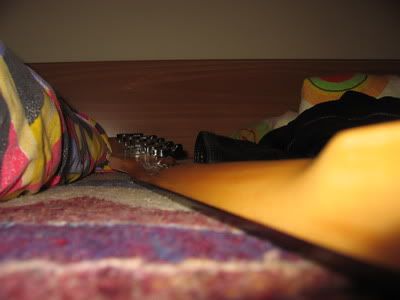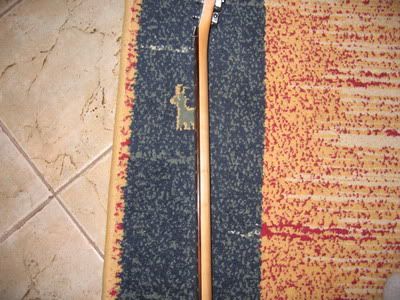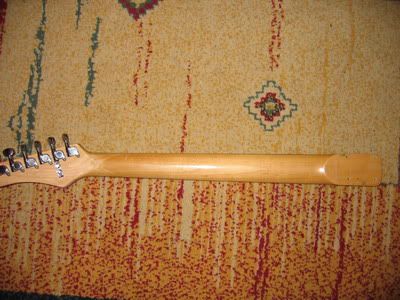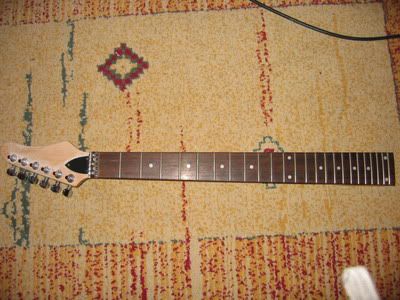
Supernova9
-
Posts
505 -
Joined
-
Last visited
Content Type
Profiles
News and Information
Tutorials
Product Reviews
Supplier Listings
Articles
Guitar Of The Month
Links and Resources
Forums
Gallery
Downloads
Posts posted by Supernova9
-
-
OK, is there a list somewhere or should we create a faq that says a Gibson fixed bridge requires a 4 1/2 degree angle. A strat fixed bridge requires no angle.
Is it different on every guitar depending on final fretboard and fret height ?
Should the fretboard be a different final height above different bridges ?
Do you calculate your best before you start and some guitars turn out better than others. Meaning they are all close but you won't be perfect every time.
It's different depending on the height of the bridge, the height of the frets and fretboard above the body, over the scale length involved.
-
Seymour Duncan's Own Website has dimensions for the pickups. Just navigate to the ones you want.
-
I've just made a fullsize copy of the strat headstock. PM me your email address and I'll send it to you.
-
hi all,i am new to the forum..looking at building my first strat style guitar,will be using a paddle headstock and need the outline of a regular fender headstock to work from..then will change the design a little as don't want it to be the same as a fender..can anyone help?many thanks,mark,.
Go to the Fender Website, look at a strat model (the more detailed, enlarged pictures they do). That gives you a nice high-res front-on shot that you can then scale up to real size for the outline then customize.
-
Many years ago I made a bad job trying to scallop a 1986 rosewood/maple skunk Fender Japan neck. Uneven wasn't the word. Fortunately I don't think I took much wood off, the problem is more of uneveness of scoop and a lack of professionalism shall we say.
So, can anyone recommend a place/person in London or therabouts who might fire a decent quote at me to sort it out?
Thanks,
A
Setch on this board is in London, you could try him, he's done work for people on here before, and the results always look very clean.
-
how many guitars are you planning on building? Or are you doing other projects in the booth?
Why so extravagant?
Says the man with the biggest pin router in the US

-
Fraid photos won't help. You need to see inside the neck, to see where the truss rod is, to know how much you can sand off the bottom, because if you leave too little wood underneath the rod, the neck could snap completely.
Seriously, make another neck or buy a similar scaled Ibanez wizard neck. Sell this one you take off to recoup some of the cash?
-
I love the look of Purpleheart (haven't heard it though) and am interested in putting a 1/4" thick bookmatched set of it on two chambered mahagany wings on a maple/ebony neck-thru guitar.
Would the Purpleheart be too bright/brittle sounding on this guitar (already with the maple neck and ebony fretboard), or would the 1/4" thick top make little to no difference?
I don't think it would. In a neck-thru the sound comes predominantly from the neck woods, so as the purpleheart is only a small portion of the less-determinant tone wood (the body wings), I don't think it'll have too great an effect. There are people on here who've built almost completely purpleheart guitars, with maple necks, and they've not complained (Drak's iceman-ish guitar iirc).
-
Yes i know, but it is kinda hard to send my guitar from Croatia to USA for painting and then back. I figure if i decide to do that it wold be cheaper to actually buy snake skin and do skin finish. LOL
I have airbrush (martel or something) it is a PRO peace of equipement but i cant draw. I even thot to do designe in photoshop or corel and send it to a printer to print directly on guitar.
You could try copying this tutorial (click here) and using some mock snake-skin fabric. Enough clear coat etc and it could look like an airbrush design at a fraction of the cost. Of course, the difficulty comes in finding snakeskin fabric that looks how you want....
-
Hey folks!
Im actually designing my own guitar and would like to use the form of the Musicman Stingray pickguard and electronic cover. Does anybody know - if they are - in what way those two parts are copyright protected?
Sorry for bad english, German here...
Thx,
mab
If you're building them for yourself, it shouldn't be a problem. Copyright laws come into play when you try to sell the guitars using said features.
-
Can anyone suggest what kind of adhesive I should use to glue a spalted maple top (1/4") to a purple heart body?
I have some epoxy based West systems left over from this past summers boat reconstruction, Would this stuff be good or is something else gooder?
Thanks!
Tom
Look for Titebond yellow glue.
-
Hi all you guitarbuilding friends!
I have just finished a mahogany/walnut bass (p-bass style) and its way to heavy

for my back. Im thinking of removing some wood from under the pickguard.. Will this affect the sound noteably? How much do you guys think i can remove?
Thanks!
Odin
Yes you can remove some wood, general suggestions I've seen on here previous suggest that you need to leave at least 1/2" left on the sides of the guitar, and a hefty portion around the bridge and neck joints.
It will affect the sound, but I wouldn't have thought it'd be very notable.
If removing that wood doesn't make enough of a weight difference, you could always rout off 1/4" from the top, chamber the whole guitar, then put on a top (some nice maple or something always looks nice imo).
-
Ah yes, very helpful. That thread's from sometime before I stumbled into this place...
After reading toddler's thread, I'm kind of tempted to go for a neck through instead...no mussing with neck pockets, tenons...and I'd be able to add the angle to my template BEFORE routing the laminates, right?
Now all I gotta do is find a fretted fretboard...
I misread your thread title - I thought you were already asking about a neck through blank, my bad. But yeah, you can make the template for the entire cross section then before you begin to build. (Which for me is a great thing, because then you HAVE to draw it out fullsize, and accurate, without diving straight in)
As for the fretted fretboard - c'mon man, you can do it! Buy a pre-radiused fretboard, make sure the slots are clean and deep enough, then you're there! (I know you can't cover it with a pickguard if it goes wrong, but hey
 )
) -
I don't understand why I'm not finding anything with the search on this, you'd think it would already have been covered, so feel free to provide links.
Here's the deal...I'm thinking of making my own neck...yep, you heard me right.
I'd like to use the wood I have here for that--the plank is long enough, but it's not quite thick enough. And besides, I like the idea of a laminated neck, in terms of stability.
I looked at garenhanman's tapered laminate tutorial--it looks like he's just taking several planks of wood and glueing them on top of each other?
My idea, however, is to use the same plank to cut out two or three profiles of the neck (i.e., use a template/router combination to roughly shape the headstock angle and heel/tenon).
I'm thinking if I use three laminates, I can cut the inside layer with the grain in the opposite direction of the outside layers. If I use two laminates, the two layers will have the grain in opposite directions. But I also have a thin plank of maple here that I can use for a center laminate instead, if that will make the neck more stable. (I don't like that striped look all that much though)
Once that's glued up, I'll be able to route for the truss rod and glue on a fretboard (if I can find a pre-fretted fretboard that is--I'm NOT yet ready to tackle that part)
The wood I have here is a nice old plank of birch...looks really good, and I'm assuming that the fact that it's still perfectly straight after at least 20 years of being stored in my father-in-law's garage is a good sign of its stability....the plank's 27 mm thick, and since it's already been planed, I won't need to take much off when I thickness it. Figure it'll still be around 25 mm/1 inch when it's cleaned up. The plank is about 150 mm long (I have a second one that's about half that length) and it's almost wide enough to make a body too...
Is this the way to do it? Sure, I could buy a neck blank, but if I can do it this way, I'd like to try.
You've been around long enough to see toddler68's neck through (remember that one with 7 stripes in the neck, paduak in the centre?) - he used the method of cutting the neck profile and scarf joint and transitions etc before gluing, and it worked well.
Only problem would be that I think it's harder to keep it all aligned while gluing like that, and leaves less margin for error if you need to plane surfaces down flat again due to creep etc.
I'm building a neck-through bass at the moment, and I did what you suggest, roughing it out (gave it an extra 3 mm on thickness of neck profile etc, and on curves), and it's going well. I wouldn't have gone down to exact dimensions before glue-up though.
Edit: Try This Thread for toddler68's guitar. First post has a pic....
-
-
Ok Guys, simple question. Wondering where I can find a UK-based supplier that stocks waterbased stains with Blue and Black (Craft Supplies doesn't stock Black in their catalogue
 )
)Anyone have any ideas? I know Axminster stock Chestnut Spirit - but that's alcohol based....
-
I always laugh at completely vague and ambiguous threads like this one. Completely lacking in any information that would help us give you a better suggestion. For example, If you want a great playing guitar, I hear Tom Anderson guitars are great for that. Of course, I wonder if you've got $2000+ to spend?
Tell us what music you want to play and your general budget, would help people make far better suggestions for you.
Also, I can't believe the number of people in this thread that made suggestions without even asking those questions.
-
I'd say option 1, simpler, and easier to do.
As for problems with polls not having enough options for 12 entries, if that is actually the case, a solution could be to put the guitars in a thread and have people post as a vote, rather than use the poll options. Then someone could collate the posts into a result (I'd be more than happy to do that if needed).
-
Hi,
I have this old SX strat neck laying around and was bored so took to the last fret with a file since I was gonna scallop it anyway just didn't have a dremel yet (still don't) and the inlay fell out. I had cream inlays and am fond of abalone for everything so I bought some abalone inlays. Now I was wondering if I should scallop the whole board, glue the inlays and then go over the inlays so that they match the scallop? Or should I inlay first? How would I get the original inlays out (dot inlays). Should I put these inlays a little deeper since I'm scalloping?
Thanks,
Cozi
Inlay first. Take out the old ones by drilling. Use a bit same diameter as the current inlays, and then all you'll do is drill out the old ones. And yes, go a little deeper if you're scalloping the board. You'll need to think how deep you're going to scallop, and modify the depth/thickness of the inlay material accordingly.
-
Just running from Something Mickguard said in another thread.
Why not run a GOTY contest - with the winners of the 12 month's categories pitched in against each other, users voting for their favourite?
-
I know there's a retail guitar available that has a headstock like that. I can't remember the maker, so I can't find it online, but it's strat style, completely standard apart from the fact that the headstock has this stylish hole cut through the centre of it.
I'm guessing therefore that there won't be a structural problem with it...
-
I've spent a good portion of the past week in the machine shop, and I'm about ready to shape the neck and glue the through-body neck to the wings (after finals week that is). Then, I'll be ready to pull out the router and go to town. any final suggestions or insight? I couls especially use suggestions regarding the shape of the electronics cavity. I have yet to make a final decision with regard to that.
Thanks for your help
What electronics are you fitting? I'd reckon you'd just want the smallest cavity the electronics require - why detract any more from the wood of the bass?
-
My questions are as follows:
1. Will disassembling the guitar in order to fix it up affect how it plays when I put it back together? I don't want to jeopardize the sound...
2. The chips in the paint reveal a nice wood underneath. Ideally I would like to strip the original paint and just keep the natural wood finish. I saw on this website the tutorial on how to strip paint by sanding, which seems straight forward enough. But I couldn't find any information about how to coat or refinish that wood (to make it look similar to those vintage P-bass or Telecasters). Can anyone point me to a website or source that will show me how to do this?
3. Any tips on how to remove the rust from the bridge and tuners? I've used vinegar on my chrome bike, but I'm not sure that will work here...
Thanks a ton,
X-Ray
1. No, provided you put it back together correctly, it should all still be the same.
2. Best way to do it is to sand off all the finish, then either coat it with oil (tru or tung), or clear lacquer (available in spray cans from StewMac)
As for removing the rust, I'm not too sure, vinegar or coke? Not sure if that'd go through the plating.
-
Those are some nice tops, but I must say that headstock shape is not exactly my preference. The tip of the headstock doesn't really fit with the rest of the flowing curves. Just something to consider.





What Do I Need For ...
in Players Corner
Posted
Indeed the pod xt does not record and let you mix/edit tracks, just lets you control the tone. For the recording part you need some kind of software like pro tools/cubase.